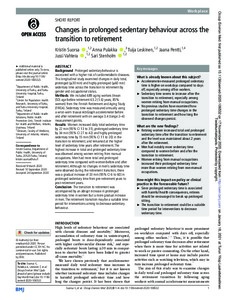| dc.contributor.author | Leskinen T | |
| dc.contributor.author | Suorsa K | |
| dc.contributor.author | Stenholm S | |
| dc.contributor.author | Pulakka A | |
| dc.contributor.author | Vahtera J | |
| dc.contributor.author | Pentti J | |
| dc.date.accessioned | 2022-10-28T13:03:35Z | |
| dc.date.available | 2022-10-28T13:03:35Z | |
| dc.identifier.uri | https://www.utupub.fi/handle/10024/162511 | |
| dc.description.abstract | <h2>Abstract</h2><div><p><strong>Background: </strong>Prolonged sedentary behaviour is associated with a higher risk of cardiometabolic diseases. This longitudinal study examined changes in daily total, prolonged (≥30 min) and highly prolonged (≥60 min) sedentary time across the transition to retirement by gender and occupational status.</p><p><strong>Methods: </strong>We included 689 aging workers (mean (SD) age before retirement 63.2 (1.6) years, 85% women) from the Finnish Retirement and Aging Study (FIREA). Sedentary time was measured annually using a wrist-worn triaxial ActiGraph accelerometer before and after retirement with on average 3.4 (range 2-4) measurement points.</p><p><strong>Results: </strong>Women increased daily total sedentary time by 22 min (95% CI 13 to 31), prolonged sedentary time by 34 min (95% CI 27 to 42) and highly prolonged sedentary time by 15 min (95% CI 11 to 20) in the transition to retirement, and remained at the higher level of sedentary time years after retirement. The highest increase in total and prolonged sedentary time was observed among women retiring from manual occupations. Men had more total and prolonged sedentary time compared with women before and after retirement. Although no changes in men's sedentary time were observed during the retirement transition, there was a gradual increase of 33 min (95% CI 6 to 60) in prolonged sedentary time from pre-retirement years to post-retirement years.</p><p><strong>Conclusion: </strong>The transition to retirement was accompanied by an abrupt increase in prolonged sedentary time in women but a more gradual increase in men. The retirement transition may be a suitable time period for interventions aiming to decrease sedentary behaviour</p></div> | |
| dc.language.iso | en | |
| dc.title | Changes in prolonged sedentary behaviour across the transition to retirement | |
| dc.identifier.urn | URN:NBN:fi-fe2021042820977 | |
| dc.contributor.organization | fi=tyks, vsshp|en=tyks, vsshp| | |
| dc.contributor.organization | fi=kansanterveystiede|en=Public Health| | |
| dc.contributor.organization | fi=väestötutkimuskeskus|en=Centre for Population Health Research (POP Centre)| | |
| dc.contributor.organization-code | 2607008 | |
| dc.contributor.organization-code | 2607307 | |
| dc.converis.publication-id | 51200491 | |
| dc.converis.url | https://research.utu.fi/converis/portal/Publication/51200491 | |
| dc.identifier.eissn | 1470-7926 | |
| dc.identifier.jour-issn | 1351-0711 | |
| dc.okm.affiliatedauthor | Pentti, Jaana | |
| dc.okm.affiliatedauthor | Vahtera, Jussi | |
| dc.okm.affiliatedauthor | Pulakka, Anna | |
| dc.okm.affiliatedauthor | Leskinen, Tuija | |
| dc.okm.affiliatedauthor | Suorsa, Kristin | |
| dc.okm.affiliatedauthor | Stenholm, Sari | |
| dc.okm.affiliatedauthor | Dataimport, tyks, vsshp | |
| dc.okm.discipline | 3142 Kansanterveystiede, ympäristö ja työterveys | fi_FI |
| dc.okm.discipline | 3142 Public health care science, environmental and occupational health | en_GB |
| dc.okm.internationalcopublication | not an international co-publication | |
| dc.okm.internationality | International publication | |
| dc.okm.type | Journal article | |
| dc.publisher.country | United Kingdom | en_GB |
| dc.publisher.country | Britannia | fi_FI |
| dc.publisher.country-code | GB | |
| dc.relation.doi | 10.1136/oemed-2020-106532 | |
| dc.relation.ispartofjournal | Occupational and Environmental Medicine | |
| dc.year.issued | 2020 | |
